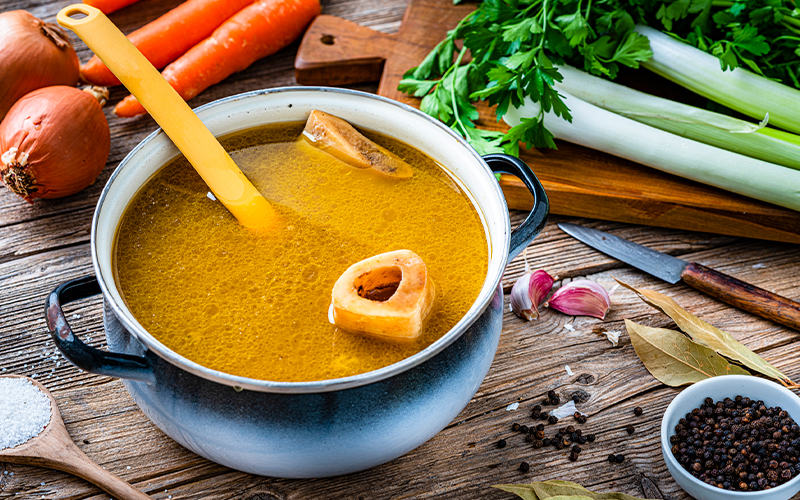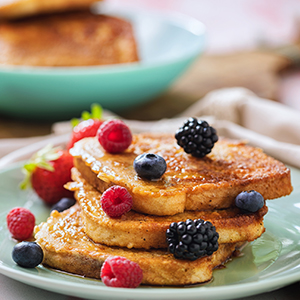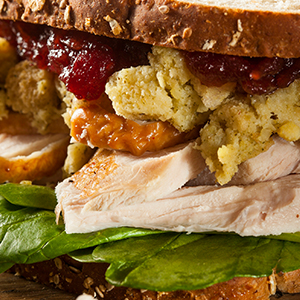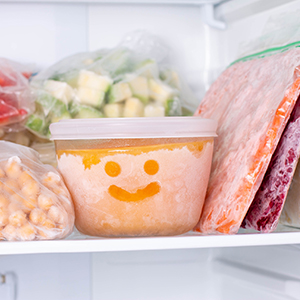8 Creative Uses for Food Scraps and Leftovers

How to Repurpose Leftovers and Food Scraps
When you think about the material clogging landfills, spoiled food might not be what comes to mind. But more than 20 tons of wasted food winds up in the trash each year. Fortunately, you can make a difference, both for the planet and your food budget by making the most of your leftovers, including food scraps.
While some types of waste (like spoiled meat) should go in the trash, using other leftovers helps save the earth and your wallet.
Make the very most of your food budget with these healthy meal tips.
Meat Bones and Veggie Scraps
Leftover ham, poultry, beef bones, and veggie scraps like the peels and tops from your potatoes, carrots, celery, etc., are the central ingredients for nourishing, flavorful soup stock or bone broth. Freeze your broth in bulk until you need it.
Bruised or Past-Ripe Fruit
Think twice before you toss those brown bananas, mushy berries, or bruised apples. While the fruit might be past ideal ripeness for sinking your teeth into, it’s still useful for baking hearty breads or tossing into smoothies. You can also cook down past-prime fruits into sauces. Simply simmer with a bit of lemon juice and top over plain yogurt with nuts and seeds for a flavorful and healthy breakfast bowl. Freeze your chopped, mashed, or pureed fruit until you’re ready to repurpose it.
Stale Bread

Did you know which popular breakfast favorite was invented as a way to use stale bread? Otherwise known as French toast, Pain perdu as it’s called in France, literally means “lost bread.” French toast makes one of the most satisfying breakfast treats – and the egg soak that revives it adds healthy protein and fat. Stale bread also makes tasty croutons, which you can freeze for later if needed. Bread also freezes well, so if it’s getting close to expiring, slice, and pop it in the freezer for toast later.
Potato Pizazz
A bag of potatoes makes a budget-friendly purchase that can stretch pretty far. Moreover, potatoes can be transformed into many meals and side dishes that you may be overlooking. Here are some fun ways to make the most of leftover spuds:
- Bake the potato skins – they make great alternative “nacho” chips for toppings!
- Place in an air fryer and crisp into old-fashioned chips
- Grate or chop them for a yummy breakfast hash
- Dice and stir them into a soup
Makeover Your Leftovers

Leftovers. Even the name makes them seem ho-hum. But when viewed in a different way – aka extra food that’s already cooked or prepared for use in a different recipe – leftovers are really something to savor.
The next time those leftover chicken thighs, beans, or hamburger just aren’t whetting your appetite, give them a new leading role in a whole different dish, like burritos, bowls, soups, salads, and casseroles. Now you have a nourishing new meal … and much of the work is done.
Other ways to enjoy leftovers:
- Eat them for lunch instead
- Give yourself a day’s break to keep variety on your menu.
- Reheat your leftovers on the stove or in the oven so they’re warmed through and feel closer to the very first bite. Warming in the oven can also keep them crispier compared to the microwave, which can make some foods soft or mushy.
- Freeze them and enjoy at a later date
Surprising Foods You Can Freeze for Later

When in doubt, befriend your freezer. Many foods can be preserved now and enjoyed later, either in their original recipe or whipped into another tasty concoction. Here’s a list of foods you can freeze that might surprise you:
- Cooked rice and other grains (add water after defrosting to reheat)
- Bread
- Herbs (“flash” freeze on a covered tray first before bagging and freezing longer-term or freeze in an ice cube tray with a bit of olive oil)
- Eggs (remove from shells first; eggs can be whipped together or yolks and whites whipped and frozen separately)
- Butter
- Chocolate
- Nuts (freezing preserves nuts’ natural oils, so they don’t go rancid)
- Cheese (shred first)
- Avocados (puree first)
- Eggplant, zucchini, squash, beans, cauliflower, and most other veggies (best for cooking soups, casseroles, sauces or other mixed dishes later)
- Bananas, grapes, citrus, and most other fruits
- Wine (freeze in small jars or ice cube trays and use for cooking later)
- Sour cream and milk (consistency after freezing is best for baking)
Get Creative!
All recipes stem from human creativity, so why not your own? Don’t be afraid to create something completely new – or a try different spin on a family favorite using what you have.
For some unique family time, challenge everyone to join in on the fun. You can even have a cook-off and see who can whip up the tastiest meal or snack from what you can find in the kitchen.
Other Budget-friendly Meal Tips
Keep it basic. Avoid choosing meals with obscure ingredients and spices that you’re not likely to use for a while – if ever. When in doubt, salt and pepper are a power duo.
Cut down on mindless snacking. If each meal has a healthy protein, fat, and carb – and you eat to satiety – you’re likely to be less hungry for snacks and sweets, which add to your grocery bill.
Eliminate flavored drinks and soda. Many people are often surprised at the health results of cutting down on soda, juice, and powdered drink mixes – even the low or no-calorie ones. Quench your thirst with water throughout the day instead and watch your food bill diminish.
Get Recipe Ideas!
Need some new recipes to spark your imagination? Visit our recipe hub, and find healthy, nourishing recipes under our Wellness and Prevention tab.
Need Help with Basic Needs?
If you’re struggling with bills, or finding enough food, shelter, or other basic needs, help is available across northern Michigan. Click on the button below to learn more about resources near you.
Suggested Blogs from Munson Healthcare:
- 12 Foods with the Healthiest Bang for Your Buck
- Fresh, Canned, or Frozen Produce
- Prediabetes: Are You At Risk?
- How to Prevent Food Poisoning